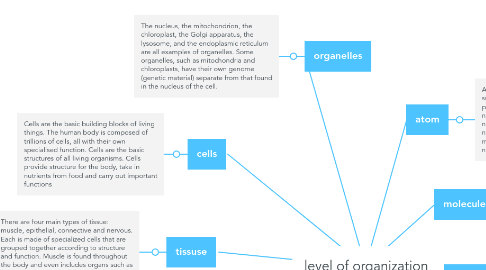level of organization
by Jason Girdley

1. organelles
1.1. The nucleus, the mitochondrion, the chloroplast, the Golgi apparatus, the lysosome, and the endoplasmic reticulum are all examples of organelles. Some organelles, such as mitochondria and chloroplasts, have their own genome (genetic material) separate from that found in the nucleus of the cell.
2. cells
2.1. Cells are the basic building blocks of living things. The human body is composed of trillions of cells, all with their own specialised function. Cells are the basic structures of all living organisms. Cells provide structure for the body, take in nutrients from food and carry out important functions
3. tissuse
3.1. There are four main types of tissue: muscle, epithelial, connective and nervous. Each is made of specialized cells that are grouped together according to structure and function. Muscle is found throughout the body and even includes organs such as the heart. Our outer layer of skin is epithelial tissue.Dec 22, 2015
4. organ system
4.1. The 11 organ systems of the body are the integumentary, muscular, skeletal, nervous, circulatory, lymphatic, respiratory, endocrine, urinary/excretory, reproductive and digestive. Although each of your 11 organ systems has a unique function, each organ system also depends, directly or indirectly, on all the others.
5. atom
5.1. Atoms are made up of three kinds of smaller particles, called protons (which are positively charged), neutrons (which have no charge) and electrons (which are negatively charged). The protons and neutrons are heavier, and stay in the middle of the atom. They are called the nucleus.
6. molecules
6.1. A molecule is a group of two or more atoms. They can be the same atom (homonuclear), such as or different atoms (heteronuclear). Some examples of homonuclear molecules include: Hydrogen.
7. organs
7.1. Organs are the body's recognizable structures (for example, the heart, lungs, liver, eyes, and stomach) that perform specific functions. An organ is made of several types of tissue and therefore several types of cells.
8. biosphere
8.1. The biosphere is defined as the area of the planet where organisms live, including the ground and the air. An example of the biosphere is where live occurs on, above and below the surface of Earth.


